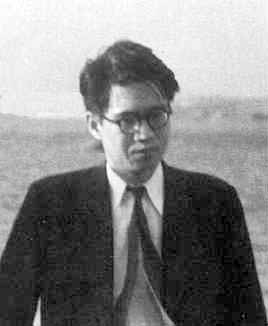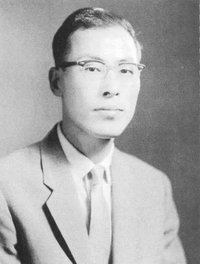<Back to Index>
- Mathematician Yutaka Taniyama, 1927
- Mathematician Goro Shimura, 1930
PAGE SPONSOR

Yutaka Taniyama (Japanese: 谷山 豊 Taniyama Yutaka; November 12, 1927, Kisai near Tokyo – November 17, 1958, Tokyo) was a Japanese mathematician known for the Taniyama - Shimura conjecture.
Taniyama was best known for conjecturing, in modern language, automorphic properties of L-functions of elliptic curves over any number field. A partial and refined case of this conjecture for elliptic curves over rationals is called the Taniyama - Shimura conjecture or the modularity theorem whose statement he subsequently refined in collaboration with Goro Shimura. The names Taniyama, Shimura and Weil have all been attached to this conjecture, but the idea is essentially due to Taniyama.
In 1986 Ribet proved that if the Taniyama - Shimura conjecture held, then so would Fermat's last theorem, which inspired Andrew Wiles to
work for a number of years in secrecy on it, and to prove enough of it
to prove Fermat's Last Theorem. Due to the pioneering contribution of
Wiles and the efforts of a number of mathematicians the Taniyama -
Shimura
conjecture was finally proven in 1999. The original Taniyama conjecture
for elliptic curves over arbitrary number fields remains open, and the
method of Wiles and others cannot be extended to provide its proof.
On November 17, 1958, Taniyama committed suicide. He left a note explaining how far he had gotten with his teaching duties, and apologizing to his colleagues for the trouble he was causing them. His mystifying suicide note read:
Until yesterday I had no definite intention of killing myself. But more than a few must have noticed that lately I have been tired both physically and mentally. As to the cause of my suicide, I don't quite understand it myself, but it is not the result of a particular incident, nor of a specific matter. Merely may I say, I am in the frame of mind that I lost confidence in my future. There may be someone to whom my suicide will be troubling or a blow to a certain degree. I sincerely hope that this incident will cast no dark shadow over the future of that person. At any rate, I cannot deny that this is a kind of betrayal, but please excuse it as my last act in my own way, as I have been doing my own way all my life.
Although his note is mostly enigmatic it does mention tiredness and a loss of confidence in his future. Taniyama's ideas had been criticized as unsubstantiated and his behavior had occasionally been deemed peculiar. Goro Shimura mentioned that he suffered from depression. Taniyama also mentioned in the note his concern that some might be harmed by his suicide and his hope that the act would not cast "a dark shadow over that person."
About a month later, Misako Suzuki, the woman whom he was planning to marry, also committed suicide, leaving a note reading: "We promised each other that no matter where we went, we would never be separated. Now that he is gone, I must go too in order to join him."
After Taniyama's death, Goro Shimura stated that:
He was always kind to his colleagues, especially to his juniors, and he genuinely cared about their welfare. He was the moral support of many of those who came into mathematical contact with him, including of course myself. Probably he was never conscious of this role he was playing. But I feel his noble generosity in this respect even more strongly now than when he was alive. And yet nobody was able to give him any support when he desperately needed it. Reflecting on this, I am overwhelmed by the bitterest grief.

Goro Shimura (志村 五郎 Shimura Gorō, born 23 February 1930) is a Japanese mathematician, and currently a professor emeritus of mathematics (former Michael Henry Strater Chair) at Princeton University.
Shimura was a colleague and a friend of Yutaka Taniyama. They wrote a book (the first book treatment) on the complex multiplication of abelian varieties, an area which in collaboration they had opened up.
Shimura then wrote a long series of major papers, extending the phenomena found in the theory of complex multiplication and modular forms to higher dimensions (amongst other results). This work (and other developments it provoked) provided some of the 'raw data' later incorporated into the Langlands program. It equally brought out the concept, in general, of Shimura variety; which is the higher - dimensional equivalent of modular curve. Even to define in general a Shimura variety is quite a formidable task: they bear, roughly speaking, the same relation to general Hodge structures as modular curves do to elliptic curves.
Shimura himself has described his approach as 'phenomenological': his interest is in finding new types of interesting behavior in the theory of automorphic forms. He also argues for a 'romantic' approach, something he finds lacking in the younger generation of mathematicians. The central 'Shimura variety' concept has been tamed (by application of Lie group and algebraic group theory, and the extraction of the concept 'parametrizes interesting family of Hodge structures' by reference to the algebraic geometry theory of 'motives', which is still largely conjectural). In that sense his work is now "mainstream - for - Princeton"; but this assimilation (through David Mumford, Pierre Deligne and others) hardly includes all of the content.
He is known to a wider public through the important modularity theorem (previously known as the Taniyama - Shimura conjecture before being proven in the 1990s); Kenneth Ribet has shown that the famous Fermat's last theorem follows from a special case of this theorem. Shimura dryly commented that his first reaction on hearing of Wiles's proof of the semistable case of the theorem was 'I told you so'.
Among many honors and awards, Shimura received the Cole Prize for number theory in 1976 and the Steele Prize for lifetime achievement in 1996, both from the American Mathematical Society. His Collected Works have been published, in five volumes.
His hobbies are shogi problems of extreme length and collecting Imari porcelain. The Story of Imari: The Symbols and Mysteries of Antique Japanese Porcelain is a non - fiction work by Goro Shimura published by Ten Speed Press in 2008.